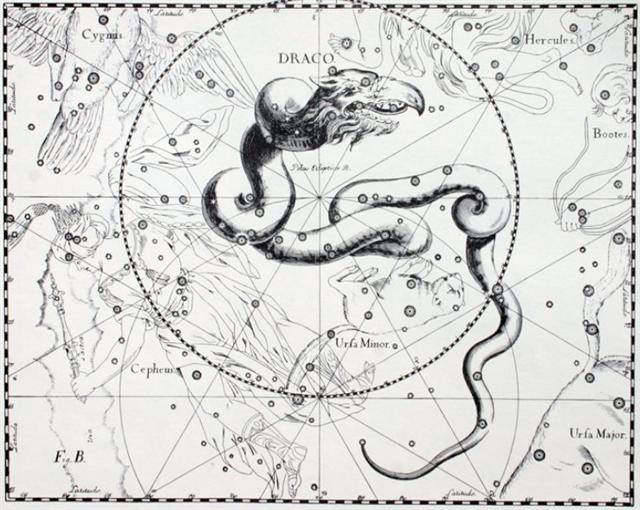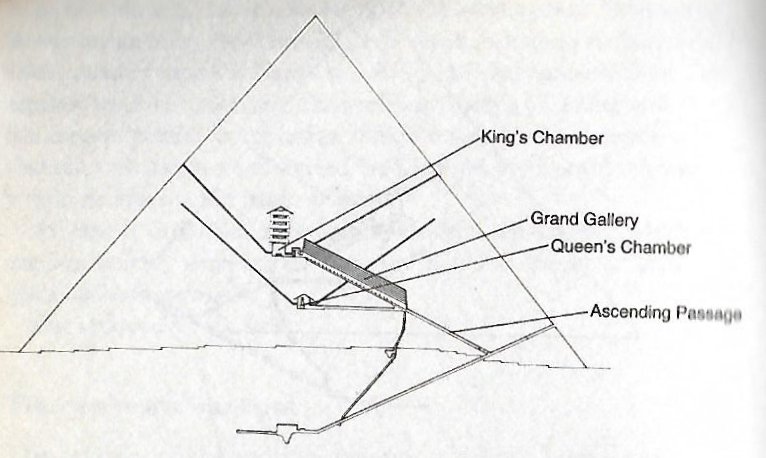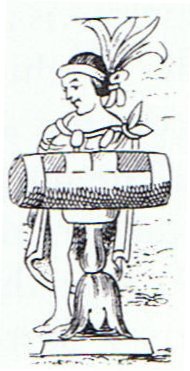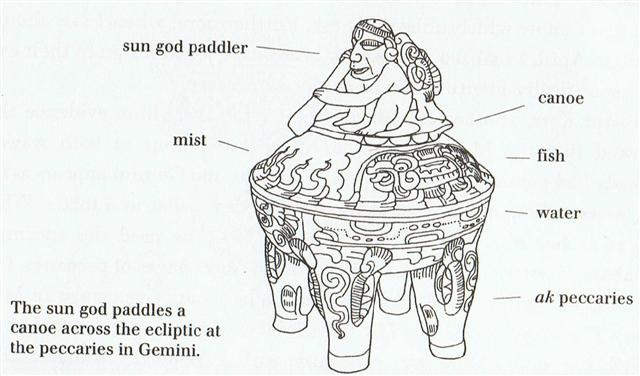A closer investigation reveals a possible correlation between
these words of Metoro and the glyphs in the following fashion:
| E tupu |
ki roto |
o te hau tea |
ki te henua -
te maro |
rutua |
|
Rutu.1. To read, to recite, to
pronounce words solemnly; he-rutu i te kohau
motu, to read the rongorongo tablets;
hare rutu rogorogo mo hakama'a ki te ga poki ite
kai, i te rogorogo, rongorongo school, house
in which children were taught reading and
writing the rongorongo signs. 2. To pelt with
stones. 3. To gather in great numbers (of
people). Vanaga. Sound. Rutu-rongorongo =
the sound of recitation. Barthel. T. Beat.
Henry. To recite; tae rutu, irreverence.
Churchill. Pau.: rutu, a drum. Mgv.:
rutu, to beat, to cause to resound. Ta.:
rutu, a drum, to drum. Mq.: utu, to
drum. Sa.: lutu, to shake a rattle.
Churchill.
 |
 |
 |
 |
 |
 |
|
Cb1-1 (393) |
Cb1-2 |
Cb1-3 |
Cb1-4 (396) |
Cb1-5 |
|
CLOSE TO THE SUN: |
|
April 17 (91
+ 16)
Al Sharatain-1 /
Ashvini-1 /
Bond-16 (Dog) /
Mahrū-sha-rishu-ku-1 (Front of the Head of Ku)
SEGIN = ε Cassiopeia, MESARTHIM = γ Arietis, ψ
Phoenicis
(27.2),
SHERATAN (Pair of Signs) = β Arietis, φ
Phoenicis (27.4)
*351.0 = *27.4 - *41.4 |
18 (108)
ι Arietis (28.0), λ Arietis (28.2), υ Ceti
(28.8) |
19
ALRISHA (The Knot) = α Piscium,
χ Phoenicis (29.2),
ε
Trianguli (29.4), ALAMAK
(Caracal) = γ Andromedae
(29.7)
*353.0 = *29.4 - *41.4 |
20
Arku-sha-rishu-ku-2 (Back of the Head of Ku)
2h
(30.4)
κ Arietis (30.3),
HAMAL (Sheep) = α Arietis
(30.5)
ALKES (α
Crateris) |
21 (111)
DELTOTUM = β Trianguli
(31.2), ι Trianguli (31.7), η Arietis (31.9) |

... The present limit of the celestial polar
regions can be defined from the declination of
the star
γ
Andromedae
... Its current place is at declination 42º 05'
N. In other words the measure across the polar
regions should be 2 * (90º - 42º 05') = 2 * 47º
55' = 95º 50' or around 96º. The width of the
polar regions is thus around 2 * 96º =
192º
and 360 - 192 =
168 = 2 * 84 (→ Julian spring equinox).
... Gamma
Andromedae ... is the third brightest star
in the constellation of Andromeda. It is also
known by the traditional name Almach
(also spelt as Almaach, Almaack,
Almak, Almaak, or Alamak),
from the Arabic
العناق
الأرض
al-‘anāq al-’arđ ...
'the caracal'
(desert lynx). Another term for this star used
by medieval astronomers writing in Arabic was
آلرخل
المسلسلة Al
Rijl al
Musalsalah 'the Woman's Foot'. In Chinese,
天大將軍 (Tiān Dà Jiāng
Jūn), meaning Heaven's Great General,
refers to an asterism consisting of γ
Andromedae, φ Persei,
51 Andromedae, 49 Andromedae, χ
Andromedae, υ
Andromedae, τ
Andromedae, 56 Andromedae, β
Trianguli, γ Trianguli
and δ Trianguli.
Consequently, γ
Andromedae itself is known as
天大將軍一 (Tiān Dà
Jiāng Jūn yī, English:
the First Star of Heaven's Great
General.) In the
catalogue of stars in the Calendarium of
Al Achsasi al Mouakket, this star was designated
جمس
ألنعامة
Khamis al Naamat,
which was translated into Latin as Quinta
Struthionum, meaning the fifth ostrich
... |
|
ko Sive
(*351). |
ko Ngehu. |
ko Hatu
(*353). |
ko Tuki. |
ko Bu
(*355). |
|
Hatu. 1. Clod of earth;
cultivated land; arable land (oone hatu).
2. Compact mass of other substances: hatu
matá, piece of obsidian. 3. Figuratively:
manava hatu, said of persons who, in
adversity, stay composed and in control of their
behaviour and feelings. 4. To advise, to
command. He hatu i te vanaga rivariva ki te
kio o poki ki ruga ki te opata, they gave
the refugees the good advice not to climb the
precipice; he hatu i te vanaga rakerake,
to give bad advice. 5. To collude, to unite for
a purpose, to concur. Mo hatu o te tia o te
nua, to agree on the price of a nua
cape. 6. Result, favourable outcome of an
enterprise. He ká i te umu mo te hatu o te
aga, to light the earth oven for the
successful outcome of an enterprise. Vanaga. 1.
Haatu, hahatu, mahatu. To
fold, to double, to plait, to braid; noho
hatu, to sit crosslegged; hoe hatu,
clasp knife; hatuhatu, to deform. 2. To
recommend. Churchill. In the Polynesian dialects
proper, we find Patu and Patu-patu,
'stone', in New Zealand; Fatu in Tahiti
and Marquesas signifying 'Lord', 'Master', also
'Stone'; Haku in the Hawaiian means
'Lord', 'Master', while with the intensitive
prefix Po it becomes Pohaku, 'a
stone'. Fornander. |
|
Gregorian equinox |
'March 22
(81) |
23 (107 - 29) |
24 |
Julian equinox |
|
"March 7 |
8 (67 = 81 -
14) |
9 (68) |
10 |
11 |
|
CLOSE TO THE FULL MOON: |
|
MUPHRID (Solitary Star) = η Bootis
(210.1), ζ Centauri (210.3) |
φ Centauri (211.0), υ¹ Centauri (211.1), υ²
Centauri (211.8), τ Virginis (211.9) |
AGENA (At the Knee) = β Centauri
(212.1), θ Apodis (212.5),
THUBAN (Dragon) = α Draconis
(212.8) |
14h (213.1)
π Hydrae, χ Centauri (213.0),
MENKENT (Shoulder of the Centaur) = θ Centauri
(213.1) |
Neck-2 (Dragon)
ASELLUS TERTIUS (3rd Ass Colt) = κ Bootis, κ
Virginis, 14 Bootis
(214.8) |

... The sky
should be moving (rutua te maeva) at the
Caracal - when the Full Moon would have been at
right ascension day *29.4 + *365¼ / 2 = *212 =
at Thuban ...

... Thuban
had been the star at the North Pole when the
great Egyptian pyramids where built ... The star
could be seen, both by day and night, from the
bottom of the central passage of the Great
Pyramid of Cheops (Knum Khufu) at Ghizeh,
in 30° of north latitude, as also from the
similar points in five other like structures;
and the same fact is asserted by Sir John
Herschel as to the two pyramids at Abousseir
...

... For some
reason, too, it had taken their fancy to place
the Great Pyramid almost exactly on the 30th
parallel at latitude 29º 58' 51". This, a former
astronomer royal of Scotland once observed, was
'a sensible defalcation from 30º', but not
necessarily in error: For if the original
designer had wished that men should see with
their body, rather than their mental eyes, the
pole of the sky from the foot of the Great
Pyramid, at an altitude before them of 30º, he
would have had to take account of the refraction
of the atmosphere, and that would have
necessitated the building standing not at 30º
but at 29º 58' 22' ... |
|
'Sept 20 (236
+ 27) |
21 (264) |
Equinox ca 76
BC |
23 |
24 (267) |
|
|
Beyond day 111 (April 21) and the first rutua of
Metoro came te pahu
at a place which corresponded to Ca1-6:
E tupu (Cb1-1) - ki roto - o te hau tea - ki te
henua - te maro - rutua
(Cb1-5) - te pahu - rutua te maeva - atua rerorero
- atua hiko ura - hiko o tea - ka higa te ao ko te henua ra
ma te hoi atua (Cb1-11) ...
|
ki te henua - tagata honui |
391 |
te pahu |
|
 |
 |
|
Ca1-6 |
Cb1-6 (6 + 392) |
|
λ Phoenicis (6.3),
β Tucanae
(6.4)
*6.4 - *41.4 + *366.0 = *331.0
= *148.0 + '183.0 |
ξ¹ Ceti
(32.1) |
|
γ
Muscae (189.0),
AVIS SATYRA (Bird of the Satyrs) =
η
Corvi
(189.3),
ASTERION (Starry) =
β
Canum Ven.
(189.5), KRAZ = β
Corvi, κ Draconis (189.7)
*331 - *183 = *148 = *189 - *41 |
Al Ghafr-13 (The Cover) /
Svāti-15 (Very Good) /
TAHUA-TAATA-METUA-TE-TUPU-MAVAE-6 (a pillar to stand
by)
15
Bootis
(215.2),
ARCTURUS =
α
Bootis
(215.4),
ASELLUS SECUNDUS (2nd Ass Colt) = ι Bootis
(215.5),
SYRMA (Train of the Virgin's Robe) =
ι
Virginis,
λ
Bootis (215.6),
η
Apodis (215.8)
*174.0 = *215.4 - *41.4 = *148 + *26 |
Pahu. Drum.
Pahu-rutu-roa = Long-beating-drum. Barthel. M. Pahū.
Tree gong. Starzecka.
Pahu uma, coffin; in
modern usage, any sort of jar. Pahupahu = To dig a
hole. Vanaga. A trough, barrel, cask, cradle, drum, chest,
box; pahu nui, a
kettle; pahu oka,
a drawer; pahu papaku,
coffin; pahu rikiriki,
sheath; pahu viriviri,
hogshead. Pahupahu,
box. Churchill. A trough, barrel, cask, cradle, drum, chest,
box; pahu nui, a
kettle; pahu oka,
a drawer; pahu papaku,
coffin; pahu rikiriki,
sheath; pahu viriviri,
hogshead; pahupahu,
box. P Mgv., Ta.: pahu,
a drum. Mq.: pahu,
a drum, a large cylindrical container. (To.:
bahu, a hollow
tree set in water as a filter.) Sa.:
pusa, a box. To.:
buha, id. Fu.:
pusa, id. Niue:
puha, id. Pau.:
puha, id.
Pahuahi, lantern,
beacon. Paukumi,
closet, cupboard. Pahupopo,
a mould; pahupopokai,
cupboard for food. Pahure:
1. To sweep everything away. 2. To wound, to lacerate, scar,
bruise, lesion, sore;
pahurehure, to wound, to scratch;
hakapahure, to
wound. T Pau.: pahure,
to be skinned; pahore,
to peel off, to scale. Mgv.:
pahore, to cut off, to chop, to slice. Ta.:
pahore, to flay,
to skin. Churchill 2.

|
rutua te maeva |
atua rerorero |
atua hiko ura |
hiko o tea |
|
Maeva. T. 1. Move.
Rangi-maeva = Moving Sky (name of a marae).
2. Greet, greeting. Henry.
Rerorero. 1. To write, to draw;
rerorero i te igoa, to sign. 2. To rape.
Vanaga. To crush, to bruise. Churchill.
Hiko.
1. To ask (for something). 2. To filch, to
pilfer. Hikohiko, to snatch by force;
robbery by assault. Vanaga. Hikohiko keke,
hide-and-seek. Churchill. Pau.: 1. To glean.
Mgv.: kohi, to gather, to collect. Ta.:
ohi, to glean. Mq.: kohi, id. Ma.:
kohi, to gather. 2. Bamboo. Mgv.: kohe,
id. Ta.: ohe, id. Mq.: kohe, id.
Sa.: 'ofe, id. Ma.: kohe, a plant
name. 3. Diarrhea. Ta.: ohi, dysentery.
Churchill. Mgv.: kohiko, a small bag
mounted in the fruit-picking fork.
Mq.: kohiko, a small net. Churchill. |
|
 |
 |
 |
 |
|
Cb1-7 |
Cb1-8 (400) |
Cb1-9 |
Cb1-10 |
|
γ,
δ
Trianguli (33.0),
χ
Persei (33.2),
10
Trianguli
(33.5),
θ
Arietis (33.3),
MIRA (Astonishing) =
ο
Ceti
(33.7) |
No star listed (34) |
ξ Arietis (35.0),
ρ Ceti (35.4), 12
Trianguli
(35.8), ξ² Ceti (35.9)
*360.0 = *35.4 - *41.4 |
σ Ceti (36.9) |
 |
|
ι Lupi, 18
Bootis
(216.3),
KHAMBALIA (Crooked-Clawed) = λ Virginis (216.4),
υ Virginis (216.5), ψ Centauri (216.6), ε Apodis
(216.8)
*175.0 = *216.4 - *41.4 |
ASELLUS PRIMUS (1st Ass Colt) = θ Bootis
(217.8) |
τ
Lupi,
δ
Oct. (218.1),
φ
Virginis (218.7)
FOMALHAUT (α Piscis Austrini) |
σ
Lupi (219.1),
ρ
Bootis (219.5),
HARIS (Keeper) = γ Bootis
(219.7) |
|
ka higa te ao ko te
henua ra ma te hoi atua |
manu rere - kua rere ga manu - ki te ragi |
|
 |
 |
|
Cb1-11 (403) |
Cb1-12 (4 * 101) |
|
CLOSE TO THE SUN: |
|
27 (117 = 91 + 26) |
April
28
(118 = 4 * 29½) |
|
ν Ceti (37.9) |
ν Arietis (38.5), δ, ε Ceti (38.8) |
|
CLOSE TO THE FULL MOON: |
|
σ Bootis (220.2),
η
Centauri (220.4)
*179.0 = *220.4 - *41.4 |
ρ Lupi (221.0),
TOLIMAN = α Centauri
(221.2), π Bootis (221.8), ζ Bootis (221.9) |
|
Oct 27 (300 = 273 = 3 * 91) |
28 |
The sound of drums may have
been there in order to break the silence and wake up
the silent bird, to make him open his mouth and
eyes, to return to life.
... Vainamoinen set about
building a boat, but when it came to the prow
and the stern, he found he needed three words in
his rune that he did not know, however he sought
for them. In vain he looked on the heads of the
swallows, on the necks of the swans, on the
backs of the geese, under the tongues of the
reindeer. He found a number of words, but not
those he needed. Then he thought of seeking them
in the realm of Death, Tuonela, but in vain. He
escaped back to the world of the living only
thanks to his potent magic. He was still missing
his three runes. He was then told by a shepherd
to search in the mouth of Antero Vipunen, the
giant ogre. The road, he was told, went over
swords and sharpened axes. Ilmarinen made shoes,
shirt and gloves of iron for him, but warned him
that he would find the great Vipunen dead.
Nevertheless, the hero went. The giant lay
underground, and trees grew over his head.
Vainamoinen found his way to the giant's mouth,
and planted his iron staff in it. The giant
awoke and suddenly opened his huge mouth.
Vainamoinen slipped into it and was swallowed.
As soon as he reached the enormous stomach, he
thought of getting out. He built himself a raft
and floated on it up and down inside the giant.
The giant felt tickled and told him in many and
no uncertain words where he might go, but he did
not yield any runes. Then Vainamoinen built a
smithy and began to hammer his iron on an anvil,
torturing the entrails of Vipunen, who howled
out magic songs to curse him away. But
Vainamoinen said, thank you, he was very
comfortable and would not go unless he got the
secret words. Then Vipunen at last unlocked the
treasure of his powerful runes. Many days and
nights he sang, and the sun and the moon and the
waves of the sea and the waterfalls stood still
to hear him. Vainamoinen treasured them all and
finally agreed to come out. Vipunen opened his
great jaws, and the hero issued forth to go and
build his boat at last ...

|

















